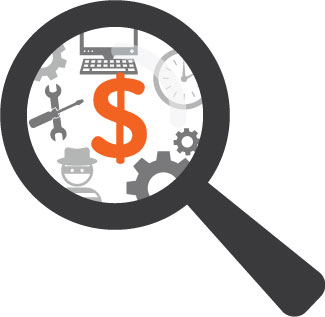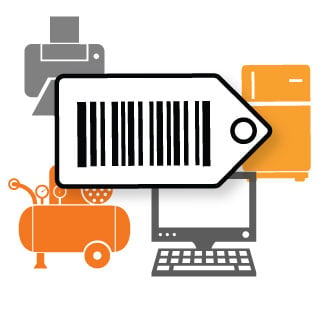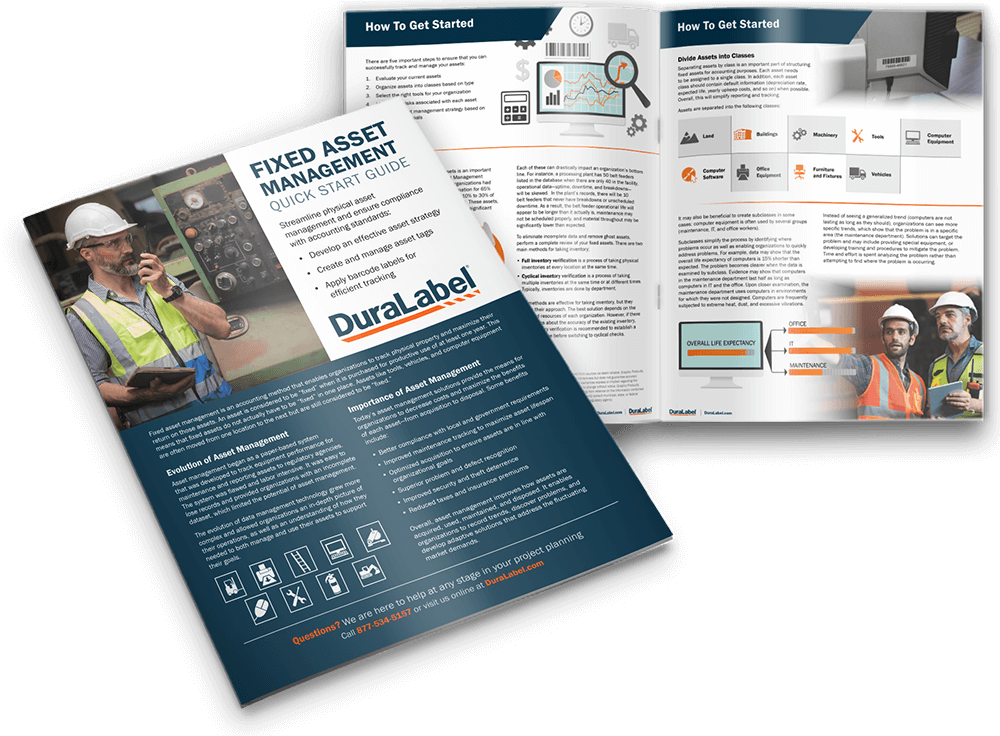Asset Tags and Their Role in Asset Management

What Are Asset Tags?
Asset tags are one of several tools needed for a successful asset management system. Asset tags are usually printed labels on durable vinyl or polyester stock and are placed on assets to improve how they are tracked. These labels usually contain a barcode and equipment ID number, as well as the company name and logo.
Used with asset management software and barcode scanners, you can gather, organize, and maintain a large amount of information about assets. In turn, this information enables you to better manage how assets are acquired, used, maintained, and disposed.
What Are Some Benefits of Asset Tags?
Many asset tags use barcodes, which can be scanned to pull up the asset's information, log maintenance information, and much more. Barcodes help reduce errors by eliminating the need to manually track and log asset information. Other benefits include:

- Simplifying tracking of assets
- Enabling comprehensive tracking of maintenance and downtime
- Enabling businesses to track costs
- Reducing costs associated with loss and theft of assets
Furthermore, when assets are misplaced, on loan, or transferred from department to department, asset tags enable you to quickly log the change and locate assets when needed. The time spent looking for these assets is greatly reduced, thereby saving time and reducing costs.
Which Assets Need Tags?
Not every asset needs a tag. Usually, assets need to be tracked if they are critical to the operation of the business, present a significant liability risk if they fail, or if they represent a significant cost if damaged, lost, stolen, or misused. This can include the following assets:
Computers and peripherals: Laptops, desktops, monitors, external hard drives, and more are listed in this category. In the long run, tagging and tracking these items helps you see the big picture and make purchasing decisions based on how assets are used.
Office equipment: Capital items such as phones, printers, TVs, and conference equipment should be tagged to help track expenses for accounting and tax purposes.
Appliances: Common appliance assets include refrigerators, microwaves, water heaters, dishwashers, air conditioners, and so on. The larger of these appliances have a significant cost and have specific maintenance requirements. Tracking these items will help account for costs, depreciation, and ensure that maintenance is performed when needed.

Machines, equipment, and tools: Turbines, transformers, hydraulic power units (HPUs), medical devices, power tools, jacks, and much more fall under this category of assets. From the largest machine to the smallest tool, these assets are often essential for day-to-day operation.
Furniture: Depending on your needs, tagging your furniture may be beneficial as well. This can include marking bookshelves, chairs, cabinets, and tables. Tracking these items improves efficiency as items move from storage to the work area as your business grows, hires new workers, rearranges the office, or transfers items from one building to another.
Vehicles: Many companies maintain vehicles for use when employees from other offices visit. Others have fleets of vans, trucks, and mobile cranes as critical components of their business. Tagging and tracking these items is essential for ensuring they are properly maintained and are available when needed.
Overall, tracking these asset types will enable your business to better assess how each is used, understand the costs, plan maintenance, standardize equipment, and reduce overhead and taxes.
What Are Some Common Mistakes to Avoid?
When tracking your assets, you need to have a clear picture of the assets in your business, from acquisition to disposal. To make your program successful, here are some common mistakes to avoid:
- Inaccurate inventory of assets
- Asset descriptions that lack manufacturer, model, and serial number information
- Asset tags that lack information that can be manually read and used in situations where asset databases cannot be accessed
- Unaccounted asset movements for acquisitions, transfers, and disposal
Information is the lifeblood of any asset management system. Before starting, your company needs to take a complete inventory of its assets, record all asset information, create tags that can be read by both scanners and human eyes, and develop strict controls for tracking assets as they are acquired, moved, maintained, and disposed of. Otherwise, information will be inaccurate and any decisions made will be based on only a partial picture.
Learn more about how you can start managing your assets, which assets to track, and how to identify potential risks with our Fixed Asset Management Quick Start Guide.
Choosing the Right Asset Tag
One way to make sure your assets can be accurately tracked is by making sure you have the right tag for your needs. Indoor assets like computers, printers, and other items will not need to be as durable as outdoor equipment, while items with a high theft rate will need to use tamper-evident tags. No matter your need, DuraLabel offers a full line of asset labeling supplies and printers to ensure your tags will remain readable.
Powerful printers like DuraLabel Toro Max enable you to print asset tags as you move from site to site. With this portable standalone printer, simply upload data from your asset management system and print the tags you need. This thermal transfer printer offers even greater flexibility with an optional battery and allows you to print up to three hours on the go, without the need to connect to a power outlet.
Related Resources

The Benefits of Asset Management Explained
Asset management is a system that helps you track your property and maximize the return on those assets, ...
Read
What Is Asset Management?
Asset management is an accounting method that enables businesses to get the most out of their assets. ...
Read
Asset Identification
For Want of a Nail Even when a small, low-value item is missing, it can result in major impact on your ...
Read.png)





